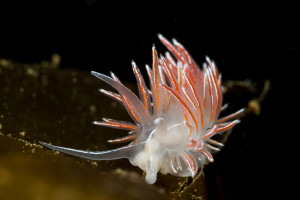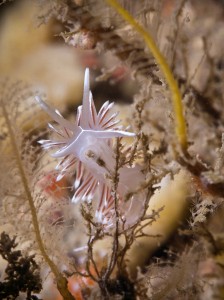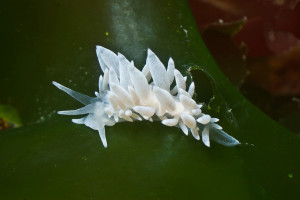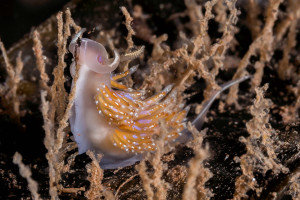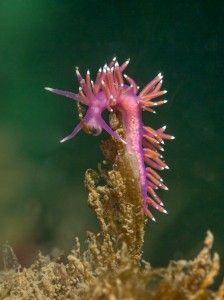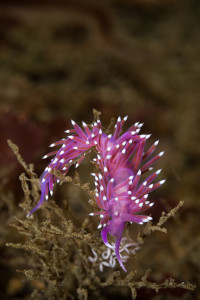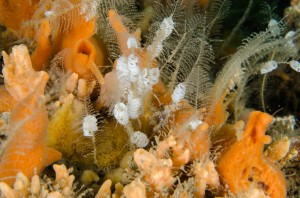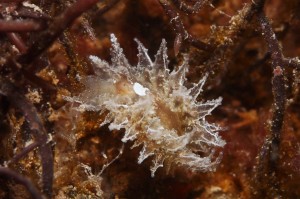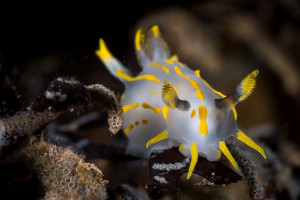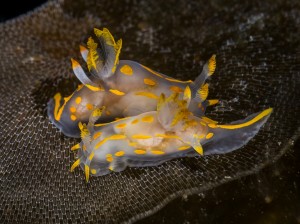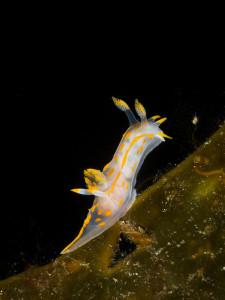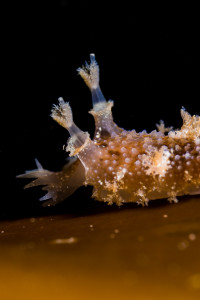Photo / Video News & Reviews
Shooting Nudibranchs
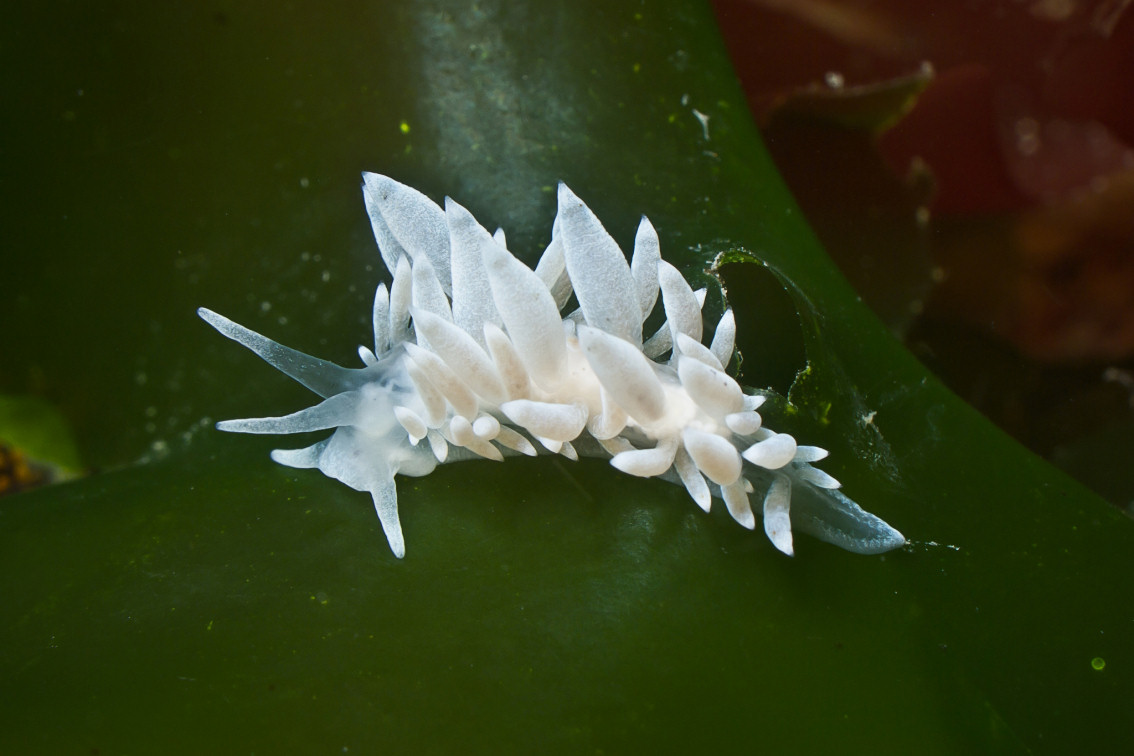
In recent years we have witnessed a rise in the popularity of nudibranchs amongst the scuba diving community, both as a photographic subject and from a natural history point of view. Now that underwater photographers and non photographers alike are seeing these little creatures with a new understanding and renewed interest in their many fascinating forms and behaviours, we are also seeing a rise in tempting photo competitions with dedicated nudibranch categories. In fact very recently I had the privilege to see almost 900 nudibranch photos submitted from photographers in 33 countries to the nudibranch Photo Competition which I was involved in running. And perhaps the most telling sign of this rise in popularity is Alex Mustard’s cover shot of a nudibranch on a UK diving magazine back in January – not a diver, drysuit or bit of shiny tech diving kit anywhere to be seen; just a gorgeous Polycera quadrilineata.
Feeding into, and feeding from, this popularity are numerous macro specific photographic trips and one or two nudibranch safaris being run around the world. A hugely popular trip based in Europe is the Gulen Dive Resort Nudibranch safari in Norway. This isn’t for the feint-hearted as water temperatures can be as low as 2 degrees C, but the clear waters and sheer numbers of slugs (both species and abundance) draws many scientists and underwater photographers to the annual event.
There is a great deal of cross-over between nudibranch photographers and marine scientists who share the same interest. The photographers gain insights into the behaviour, location and abundance of many species; and the scientists get access to many detailed images and greater number of in-water observations that would normally not be possible.
Many photographers develop their own favourite style or technique for shooting in different situations; quite often this is led by the development of new kit, or simply what is considered a fashionable ‘look’ at the time. Taking images of nudibranchs is no different and their many shapes, sizes and forms make them suitable subjects for a variety of techniques.
The most basic approach is to see them as a traditional macro subject and apply tried & tested rules of engagement: macro lens, high shutter speed, small aperture and strobes. Compact camera users need not feel left out, as many models have superb macro capabilities which can be further enhanced using additional close-up ‘wet’ lenses.
Moving beyond this method can open up a whole new creative world to the slug shooter. If you like velvety black backgrounds you might want to try using snoots on your strobes, using ‘inward-lighting’ techniques (where you aim your strobes back in towards the camera & use the very edge of the light cone to light the subject), and cutting your kit down to just a single handle and strobe to facilitate getting very close to your subject.
Going in the opposite direction and keeping some ambient light in your shots will often involve careful control of the strobe as TTL metering sometimes tends to overexpose in this situation so using your strobe in manual can yield much better results.
If you are shooting in temperate waters where ambient light levels are very much lower, keeping an adequate depth-of-field by using your aperture will necessitate using higher ISO settings & lower shutter speeds to let that light into your image. Playing to the strengths of your kit in these situations always pays dividends; if your image stabilization is better than your high ISO performance, then use slower shutter speeds, if not then ISO should be your tool of choice.
Taking a different view of nudibranchs is perhaps where you’ll start to see the greatest opportunities for amazing photos. Observation can be the key to getting interesting behaviour photos and as these critters can move surprisingly quickly, take some practice shots before you carefully approach the subject so you are ready for the action.
Almost every aspect of a nudibranch’s life can be used for behaviour photography; aggregations, mating, egg-lying, feeding, cresting a pebble or frond of weed and sometimes even swimming in midwater give plenty of chances if you know where & when to look.
Close-focus wide-angle is another technique which can be applied to the larger species of nudis. Again, compact camera users are not disadvantaged because many wideangle or fisheye wet lenses have very good close focusing abilities. The most problematic aspect of a CFWA nudibranch shot is getting the light to the subject; the ability to reduce the size of your camera rig and get your strobes as tight to your port as possible is the key. This approach can be used to include a diver in the shot, or perhaps more interestingly place the nudibranch in its habitat – often they feed and live in very colourful and interesting places which can be used to make beautiful images.
As is common practice amongst the majority of underwater photographers, a respect for nudibranchs and their habitat is paramount. This is not just for the benefit of the slugs themselves because if you adopt a sensible and conservation-minded attitude in the water then your images will benefit too.
Many species of nudibranch live on mucky/silty sites so poor finning technique or buoyancy will disturb the sediment and ruin your photographic opportunities.
In every corner of the globe where slugs are found, using just one finger to steady yourself while keeping your body/fins away from the reef/wall/sea-bed should be your standard approach. Just because you can’t see a slug or its food or eggs doesn’t mean they’re not there!
If you shoot for competitions, nudibranchs are a surprisingly versatile subject in their own right and you don’t even need a dedicated category to benefit from their many forms. Lots of competitions have ‘abstract’, ‘behaviour’ and ‘portrait’ categories which all lend themselves to photos of nudis. Applying the techniques discussed previously you’ve also got opportunities in ‘traditional macro’, ‘super macro’ and ‘wide-angle’ categories too.
Sometimes competitions throw up oddly themed sections to test the entrants’ creative abilities. Themes like ‘reflections’, or ‘yellow’ and ‘camouflage’ can all be useful to the nudibranch photographer if you know your species and have the ability to go & find them!
If in-camera manipulation is permitted you can try your hand at a double (or more) exposure that places a close-up shot of a nudibranch onto a cleverly exposed sun-ball or diver silhouette. Tricky to pull off well; but stunning if done properly.
The increasing appeal of nudibranchs is perhaps, in part, down to the fact that there are still new species waiting to be discovered. Even in the most popular diving destinations in the world, every now and then something new pops up and gets the scientists, and photographers, all excited.
In completing the necessary dives for my recent iBook on nudibranchs of south west England, my buddy (and fellow author) Terry Griffiths and I stumbled upon a potential 4 new species whilst diving sites we had be visiting for many years.
It will take some time, and many more dives, to confirm; but the fact illustrates that there’s still so much more out there to be discovered.
Blogs
Diver Discovering Whale Skeletons Beneath Ice Judged World’s Best Underwater Photograph
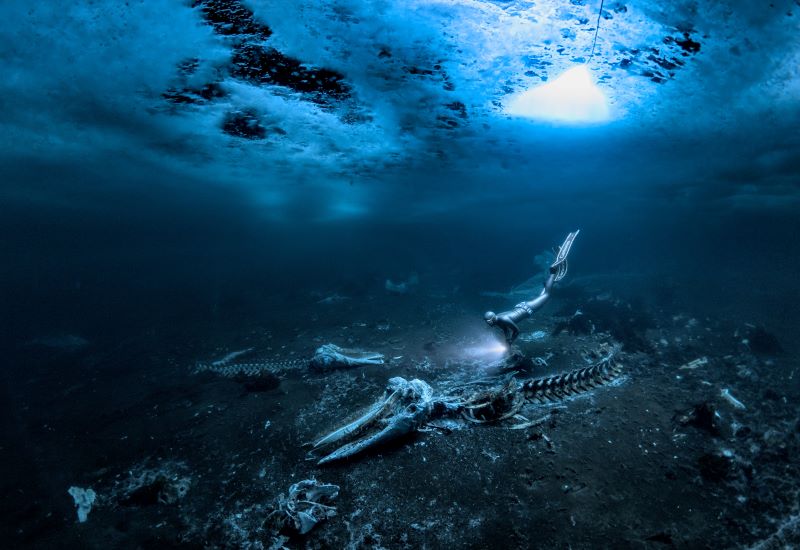
An emotive photograph showing a freediver examining the aftermath of whaling sees
Alex Dawson from Sweden named Underwater Photographer of the Year 2024. Dawson’s
photograph ‘Whale Bones’ triumphed over 6500 underwater pictures entered by underwater
photographers from around the world.
“Whale Bones was photographed in the toughest conditions,” explains chair of judging
panel Alex Mustard, “as a breath-hold diver descends below the Greenland ice sheet to bear
witness to the carcasses. The composition invites us to consider our impact on the great
creatures of this planet. Since the rise of humans, wild animals have declined by 85%. Today,
just 4% of mammals are wildlife, the remaining 96% are humans and our livestock. Our way
needs to change to find a balance with nature.”
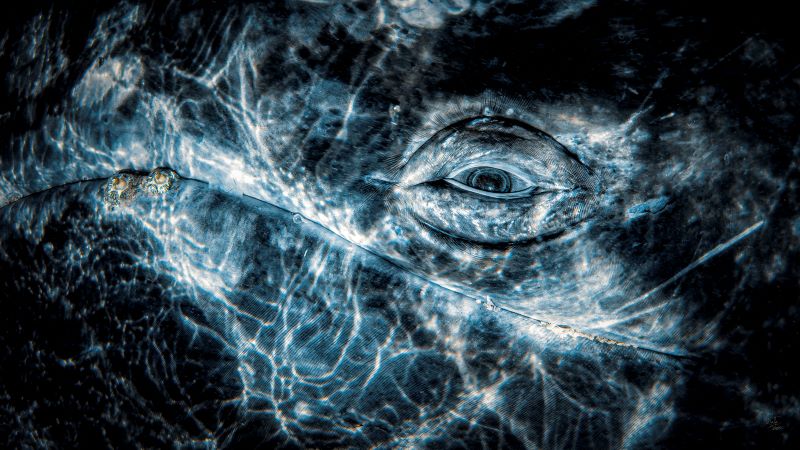
Photo: Rafael
Fernandez Caballero
Whales dominated the winning pictures this year with Spanish photographer Rafael
Fernandez Caballero winning two categories with his revealing photos of these ocean giants:
a close up of a grey whale’s eye and an action shot of a Bryde’s whale engulfing an entire bait
ball, both taken in Magdalena Bay, Baja California, Mexico. Fernandez Caballero took ‘Grey
Whale Connection’ while drifting in a small boat, holding his camera over the side in the water
to photograph the curious whale. ‘The End Of A Baitball’ required Fernandez Caballero to dive
down and be in exactly the right place at the moment the whale lunged. “The photo shows
the high speed attack,” he said, “with the whale engulfing hundreds of kilograms of sardines
in one bite — simply unforgettable to see predation on such a scale.”
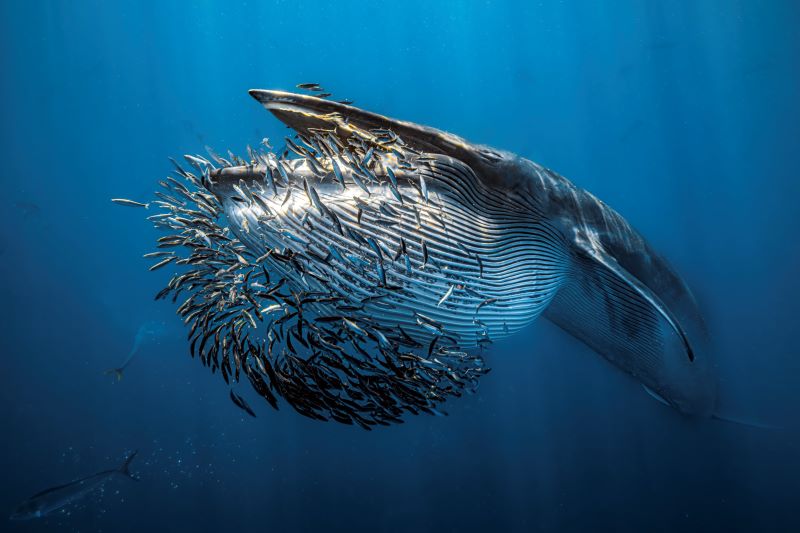
Photo: Rafael
Fernandez Caballero
Lisa Stengel from the United States was named Up & Coming Underwater Photographer of the Year 2024 for her image of a mahi-mahi catching a sardine, in Mexico. Stengel used both a very fast shutter speed and her hearing to catch the moment. “If you listen there’s an enormous amount of sound in the ocean,” she explained. “The action was too fast to see, so I honed in on the sound of the attacks with my camera to capture this special moment.”
“It is such an exciting time in underwater photography because photographers are capturing such amazing new images, by visiting new locations and using the latest cameras,”
commented judge Alex Mustard. “Until this year I’d hardly ever see a photo of a mahi mahi,
now Lisa has photographed one hunting, action that plays out in the blink of an eye.”
The Underwater Photographer of the Year contest is based in the UK, and Jenny Stock,
was named as British Underwater Photographer of the Year 2024 for her image “Star
Attraction”, which finds beauty in species of British wildlife that are often overlooked.
Exploring the west coast of Scotland, Stock explained “in the dark green depths my torch
picked out the vivid colours of a living carpet of thousands of brittle stars, each with a
different pattern. I was happily snapping away, when I spotted this purple sea urchin and I
got really excited.”
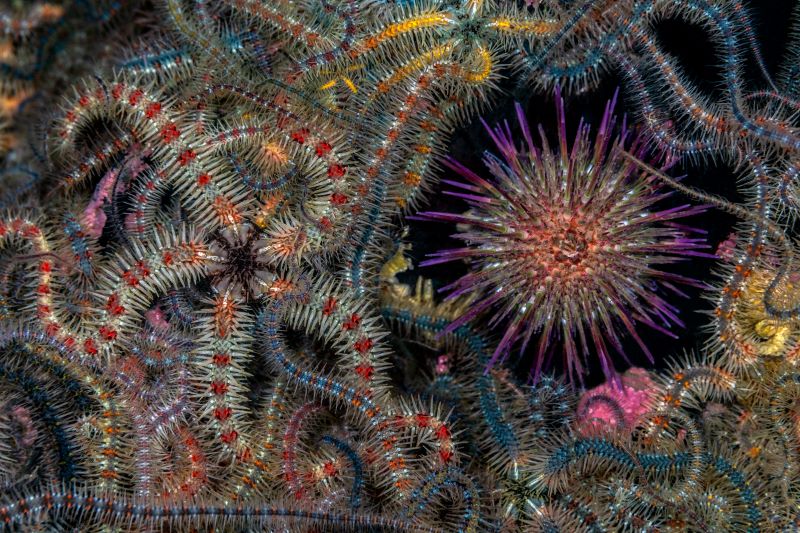
Photo: Jenny Stock
In the same contest, Portuguese photographer, Nuno Sá, was named ‘Save Our Seas
Foundation’ Marine Conservation Photographer of the Year 2024, with his photo ‘Saving
Goliath’, taken in Portugal. Sá’s photo shows beachgoers trying to save a stranded sperm
whale. The picture gives us hope that people do care and want to help the oceans, but also
warns us that bigger changes are needed. “The whale had been struck by a ship and its fate
was sealed,” explains Sá. “An estimated 20,000 whales are killed every year, and many more
injured, after being struck by ships-and few people even realise that it happens.”
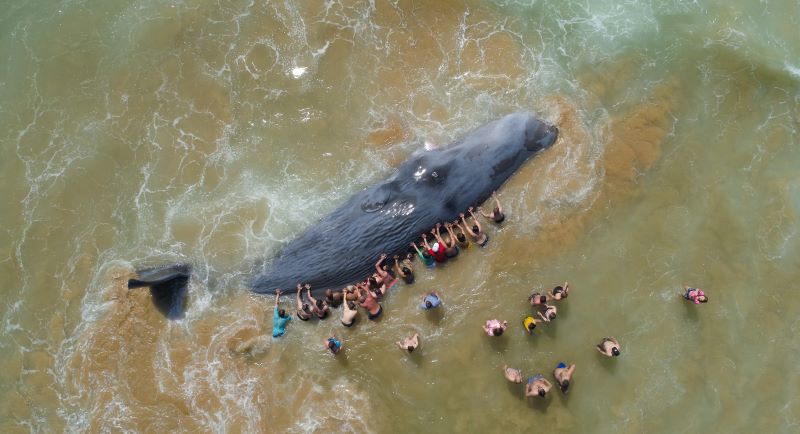
Photo: Nuno Sá
More winning images can be found at www.underwaterphotographeroftheyear.com.
About Underwater Photographer of the Year
Underwater Photographer of the Year is an annual competition, based in the UK, that celebrates photography beneath the surface of the ocean, lakes, rivers and even swimming pools, and attracts entries from all around the world. The contest has 13 categories, testing photographers with themes such as Macro, Wide Angle, Behaviour and Wreck photography, as well as four categories for photos taken specifically in British waters. The winners were announced in an award ceremony in Mayfair, London, hosted by The Crown Estate. This year’s UPY judges were experienced underwater photographers Peter Rowlands, Tobias Friedrich and Dr Alexander Mustard MBE.
Header image: Underwater Photographer of the Year 2024 winner Alex Dawson
News
World’s Best Underwater Photographers Unveil Breathtaking Images at World Shootout 2023
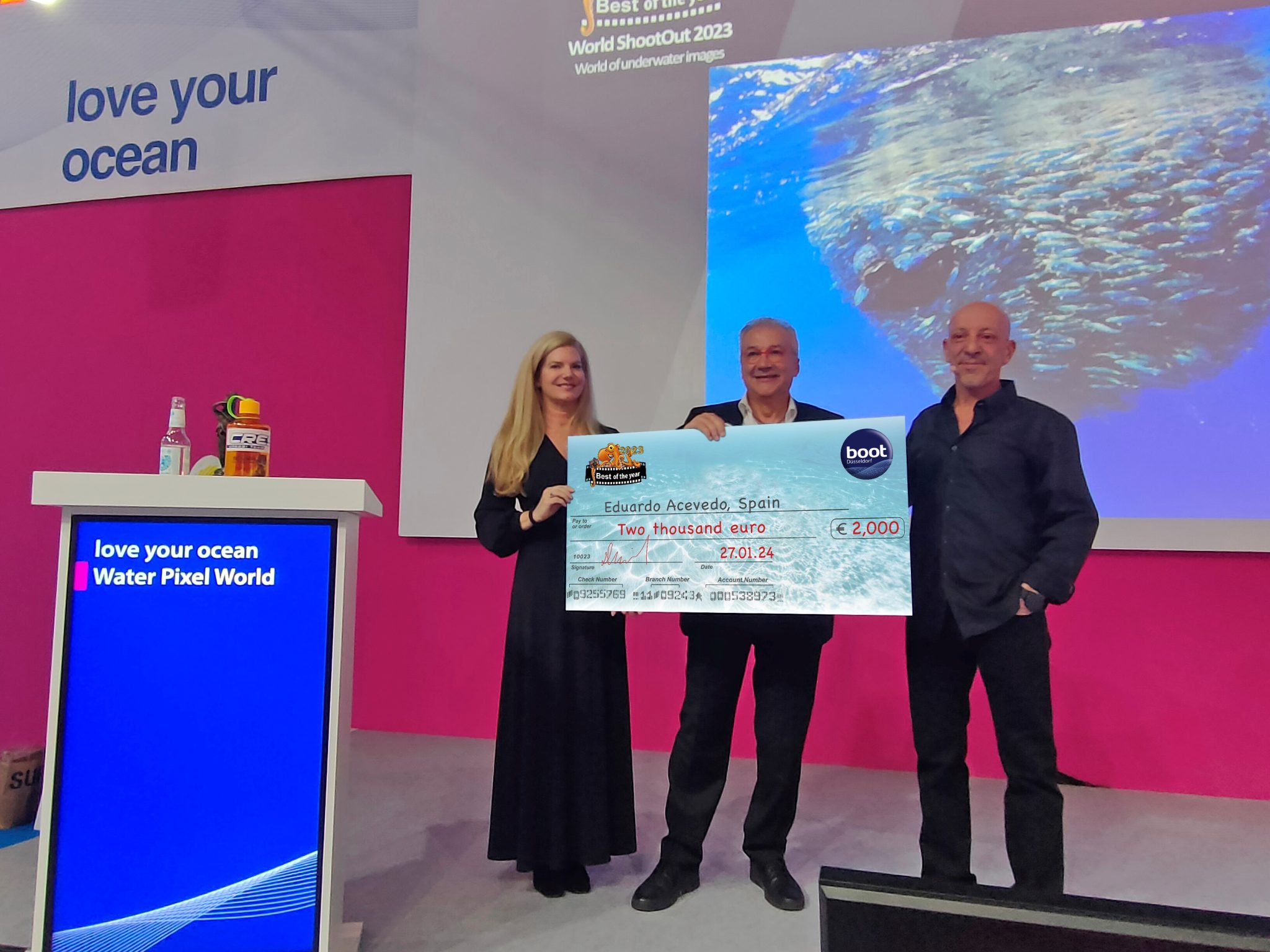
The winners of the prestigious World Shootout 2023 underwater photography competition were announced at this year’s BOOT Show, captivating audiences at the world’s largest diving and water sports exhibition in Dusseldorf, Germany. Hundreds of photographers from 54 countries competed across nine categories, pushing the boundaries of creativity and technical skill.
Grand Prize Winners
- Picture of the Year: Spanish photographer Eduardo Acevedo “secured” the top Honor with the prestigious prize the “boot Dusseldorf Director’s Prize, earning an Andromeda statuette and a €2,000 cash prize.
- Best 5 Images Portfolio: Luc Rooman from Belgium triumphed in this category, winning a dream 4-week diving trip for two to Papua New Guinea, valued at $18,900.
- Amateur Photographer: Alexandra Ceurvorst from the USA impressed the judges with her talent, taking home the 1,000 € cash prize award.
Celebrating Diversity and Innovation
This year’s competition saw 11,680 entries from 964 photographers, showcasing a remarkable spectrum of skills and perspectives. From the intricate wonders of Macro photography to the beauty of “Black Water”, the “Underwater Fashion” category added a touch of artistry and innovation, while the ever-important ” Environmental & Conservation” category served as a powerful reminder of the need to protect these fragile ecosystems.
Looking Ahead: AI and Ocean Conservation
World Shootout founder and producer David Pilosof unveiled an exciting addition for the 2024 competition: this year the Environmental category will be focusing on the impact of plastic on our oceans and future.
This category will embrace the potential of AI or other editing software as a tool to amplify the conservation message.
Entrants will submit campaigns of three original underwater photographs dealing with plastic pollution, along with their final AI assistance processing. This innovative approach encourages artistic expression while raising awareness about a critical environmental issue.
Explore the Stunning Collection
Discover the complete album of competition entries by clicking here.
For Low-resolution photos of finalist entries in eight categories, click here.
-

 News3 months ago
News3 months agoHone your underwater photography skills with Alphamarine Photography at Red Sea Diving Safari in March
-

 News2 months ago
News2 months agoCapturing Critters in Lembeh Underwater Photography Workshop 2024: Event Roundup
-

 Marine Life & Conservation Blogs2 months ago
Marine Life & Conservation Blogs2 months agoCreature Feature: Swell Sharks
-

 Blogs1 month ago
Blogs1 month agoMurex Resorts: Passport to Paradise!
-

 Blogs2 months ago
Blogs2 months agoDiver Discovering Whale Skeletons Beneath Ice Judged World’s Best Underwater Photograph
-

 Gear News3 months ago
Gear News3 months agoBare X-Mission Drysuit: Ideal for Both Technical and Recreational Divers
-

 Gear Reviews2 months ago
Gear Reviews2 months agoGear Review: Oceanic+ Dive Housing for iPhone
-

 Marine Life & Conservation2 months ago
Marine Life & Conservation2 months agoSave the Manatee Club launches brand new webcams at Silver Springs State Park, Florida


